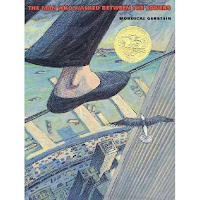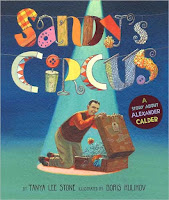For the past nine months or so, I’ve dug deeply into the structure, tone, focus, and storytelling techniques of hundreds of nonfiction picture book biographies. Picture book writing is itself an incredible challenge, but telling a true story in a compelling and creative way, with very few words, is a unique art. I thought it might be fun to blog about some of my observations, choosing just a few different titles for each post. For consecutive blogs, I’ll talk a bit about different structural considerations of this wonderful genre. Today, I’ll start with focus.
Why is focus so important to nonfiction picture books? Because the author generally has a great big story, often covering a lifetime, to squeeze into a teeny tiny space. Picture book biographies, as Tanya Lee Stone wrote in 2007, “strives to capture that which is least tangible- the essence of an individual’s life.”
I’m sure there are more succinct definitions for the term, but here’s my take on what focus means: As if zooming a lens into the life of an individual, Focus is the marriage of a specific time frame within a subject’s life, and a unique talent of, event of, or global contribution by the subject.
The Man Who Walked Between the Towers, by Mordicai Gerstein, Caldecott Medal winner (Roaring Brook, 2003)
775 words – Time Frame – a single day- August 7, 1974
Angle: Rather than chronicling the entire life of famous rope-walker, Philippe Petit, the book begins with it’s focus, a singular event- The day Petit walked a 5/8″ cable stretched between the rooftops of the New York Trade Center Towers.
The Mermaid Queen, by Shana Corey, illustrated by Edwin Fotheringham (Scholastic Press, 2009)
1022 words – Time frame- From early childhood in 1903 when “Annette Kellerman loved to make waves.” to presumably early adulthood (no date progression is offered in text, but illustrations fill in the blank.)
Angle: A true snapshot of a large life, the book’s story offers a broad introduction to how Annette Kellerman swam her way out of leg braces, into sports history, and into her role as role-model for women.
(The author’s note offers a much more indepth look into Kellerman’s life, making me appreciate the difficulty of narrowing this story with such artful treatment.)
Sandy’s Circus, by Tanya Lee Stone, illustrated by Boris Kulikov
952 words (Viking, 2008) Time frame- early childhood through perhaps mid career.
Angle- Rather than a broad introduction to the career of well known artist/sculptor, Alexander Calder, inventor of the mobile, the book focuses on his invention of and performance of the famous tiny circus, created entirely from every day objects like wire, cork, buttons, cloth, etc.
The Day-Glo Brothers: The True Story of Bob and Joe Switzer’s Bright Ideas and Brand-New Colors, by Chris Barton (Charlesbridge, 2009) 2010 Sibert Honor book
2084 words – Time Frame – early childhood (first brother born in 1914) through approx. 1940’s.
Angle: Though the book offers generous insight into the individual talents and interests of brothers, Bob and Joe Switzer, the story zeroes in on the brother’s invention of and popularization of the famously glowing hues known as Day-Glo colors.
What I’ve learned from examining these and other titles is that focus is key. If, like me, you’re writing a nonfiction picture book, it’s important to ask yourself, which part of my subject’s great big story am I going to tell?
Quote for the day: “Not that the story need be long, but it will take a long while to make it short.” Henry David Thoreau





Thank you for this post. My middle daughter has to read books from many genres for her summmer homework and we will check out these biographies.
Pragmatic Mom
Type A Parenting for the Modern World
http://PragmaticMom.com
I blog on children's lit, education and parenting
but clearly not enough on non-fiction picture books as your picks were new to me!
So glad the short list was helpful to you. I'll be highlighting additional titles as I continue with this series of nonfiction picture book dissections, so check back periodically.
I've studied literally hundreds of nonfiction picture books, so if you're looking for specific subjects, just shoot me an email and I'll be happy to share my recommendations.